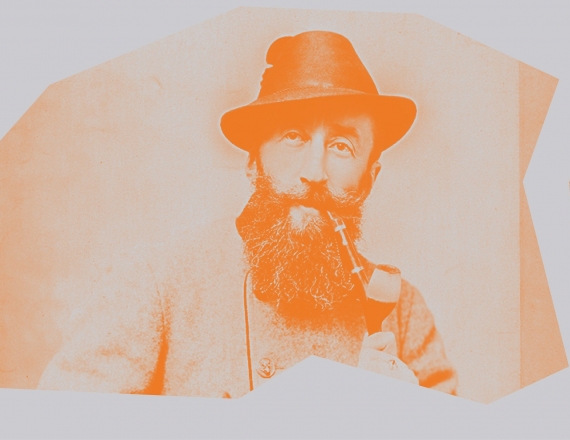NEWS
The exhibition “DISCOVERED IMAGES... ”
The exhibition “DISCOVERED IMAGES... ”
A growing conviction that photography is an art led to the emergence of pictorialism: the first artistic movement in the history of photography. Pictorialists emphasised the beauty of the subject matter and the photo’s tonality and composition over its documentary aspect. They began to set up associations, organise exhibitions and publish papers. The Linked Ring was founded in London (1892), Paris saw the establishment of the Photo-Club de Paris (1894), Vienna and Berlin became important centres of new photography. In former Poland, the Austrian partition also witnessed the emergence of a fine-art photography movement.
The exhibition presents photographs from the collections of Šiauliai Aušros Museum, Lithuanian National Museum of Art, Kaunas District Museum, Trakai History Museum and Gražina Petraitienė’s private collection
The exhibition curators: Dr Dainius Junevičius, Dr Małgorzata Grąbczewska
Coordinators: Vilija Ulinskytė-Balzienė, Anna Szary
Graphic designer Juozapas Švelnys
Architect Jurgis Dagelis
The exhibition is held under the auspices of the President of the Republic of Poland Andrzej Duda and the President of the Republic of Lithuania Gitanas Nausėda
With the financial support of the Lithuanian Council for Culture
Sponsor – Auction House ARS VIA (Lithuania)
The exhibition was organised by the Šiauliai Aušros Museum in cooperation with the Royal Lazienki Museum in Warsaw (Poland)
More information>>
-----------------------------------------------------------------
PL
Wystawa fotografii "Odnalezione obrazy. Fotoestetyka hrabiego Benedykta Henryka Tyszkiewicza"
Blisko 200 oryginalnych odbitek, niezwykle interesujących ze względu na swoje walory fotograficzne, prezentuje wystawa twórczości Benedykta Henryka Tyszkiewicza, polsko-litewskiego arystokraty i fotografia. XIX-wieczne prace, przez lata uznawane za zaginione, pochodzą z litewskich zbiorów.
Wystawa powstała we współpracy Muzeum Łazienki Królewskie w Warszawie i Muzeum Fotografii w Szawle (Siauliai). Ekspozycja przybliża twórczość Benedykta Henryka Tyszkiewicza, polsko-litewskiego arystokraty, który rodzinną fortunę wykorzystał m.in. do rozwoju pasji fotograficznej.
Przez długi czas uważano, że wszystkie jego prace zaginęły, a to, co stworzył, było znane jedynie dzięki relacjom jemu współczesnych, nielicznym publikacjom w prasie i kilku zachowanym fotografiom. To wystarczyło, by Benedykt Henryk Tyszkiewicz znalazł miejsce w historii fotografii francuskiej, polskiej i litewskiej. Kilkadziesiąt lat temu jego prace ponownie pojawiły się w przestrzeni publicznej. Były to dwa niewielkie zbiory autorskich odbitek, które zaprezentowane zostały na wystawie w Muzeum Nicephore Niepce we Francji. Kolejny, ogromny zbiór pojawiły się w ostatnich latach na Litwie, dzięki staraniom małżeństwa kolekcjonerów, Gražiny i Gediminasa Petraitisów. To z niego m.in. pochodzą fotografie prezentowane na wystawie w Łazienkach Królewskich.
W Stajniach Kubickiego obejrzymy blisko 200 oryginalnych odbitek, powstałych w latach 1892-1898. Przedstawiają one życie i dzieło Tyszkiewicza, jak również Litwę, Polskę i Europę, ich społeczeństwa, obyczaje i kulturowe dziedzictwo. Poza reportażem i migawkami z podróży, polsko-litewski artysta eksplorował granice fotografii poprzez grę między tym co prawdziwe a udawane, żart, inscenizację.
Ułożone tematycznie odbitki prezentują Tyszkiewicza jako bogatego ziemianina (sceny z polowań, życie w Wiałej, wnętrza pałaców), podróżnika (Zakopane, Nicea), etnografa (zdjęcia litewskich chłopów, polskich górali), portrecistę czy artystę piktorialistę (inscenizowane fotografie francuskich aktorek). Poznamy jego artystyczne i naukowe ambicje, a także związki z Polską i Litwą, które - mimo wielu lat spędzonych we Francji - pozostały dla niego domem i miejscem przechowywania rodzinnej kolekcji sztuki. Twórczość Tyszkiewicza, niezwykle interesująca ze względu na swoje walory fotograficzne, jest również świadectwem okresu szczególnej żywotności polsko-litewskiej wspólnoty kulturowej, której dziedzictwo jest podstawą wyjątkowej więzi łączącej oba narody.
Wystawa "Odnalezione obrazy. Fotoestetyka hrabiego Benedykta Henryka Tyszkiewicza (1852-1935)" została objęta Honorowym Patronatem Prezydenta RP Andrzeja Dudy oraz Prezydenta Republiki Litewskiej Gitanasa Nausėdy.
Na wystawie prezentowane są fotografie z Muzeum Aušros w Szawlach, Litewskiego Narodowego Muzeum Sztuki, Muzeum Rejonu Kowieńskiego, Muzeum Historycznego w Trokach oraz prywatnej kolekcji Gražiny Petraitienė.
Kiedy: Wystawa czynna od 8 grudnia 2023 roku do 10 marca 2024 roku.
Kuratorzy: dr Dainius Junevicius, dr Małgorzata Maria Grąbczewska
Organizatorzy: Muzeum Aušros w Szawlach (Litwa), Muzeum Łazienki Królewskie (Polska)
Wsparcie finansowe: Litewska Rada Kultury
Sponsor: Dom aukcyjny ARS VIA (Litwa)
Projekt graficzny: Juozapas Švelnys
Architekt: Jurgis Dagelis
 Chaimas Frenkelis Villa-Museum
Chaimas Frenkelis Villa-Museum
 Venclauskiai House-Museum
Venclauskiai House-Museum
 Šiauliai History Museum
Šiauliai History Museum
 Photography Museum
Photography Museum
 Bicycle Museum
Bicycle Museum
 Radio and Television Museum
Radio and Television Museum
 Žaliūkiai Village Miller’s Farmstead-Museum
Žaliūkiai Village Miller’s Farmstead-Museum
